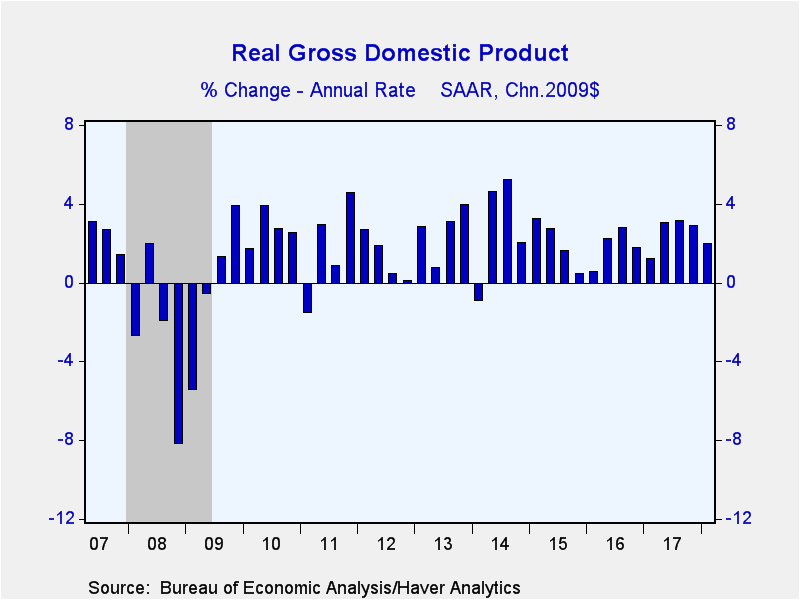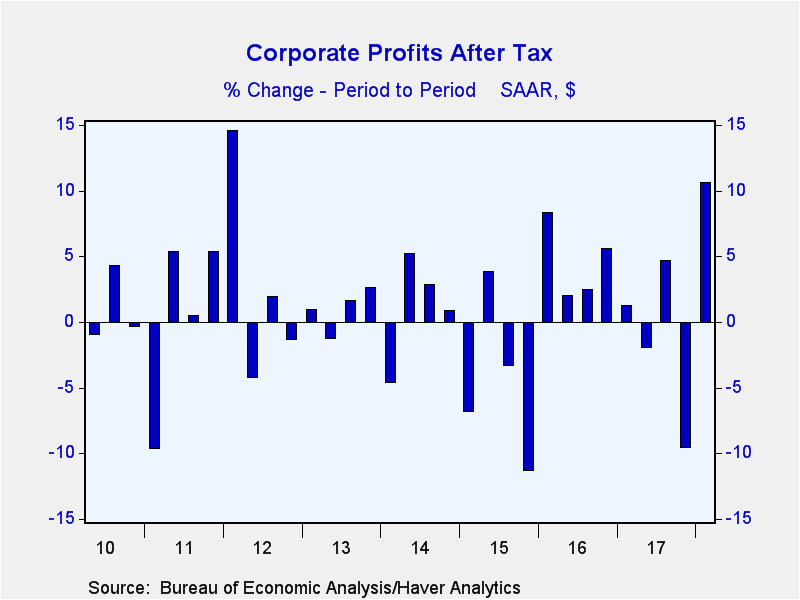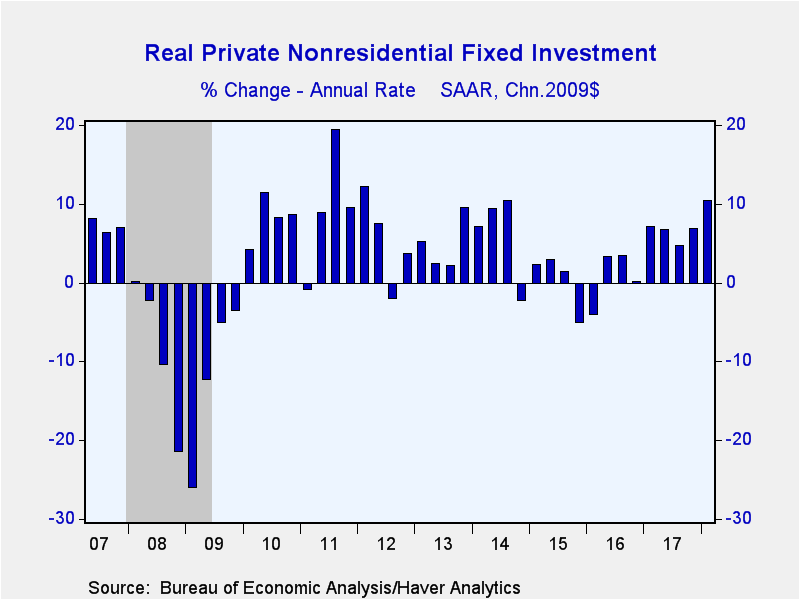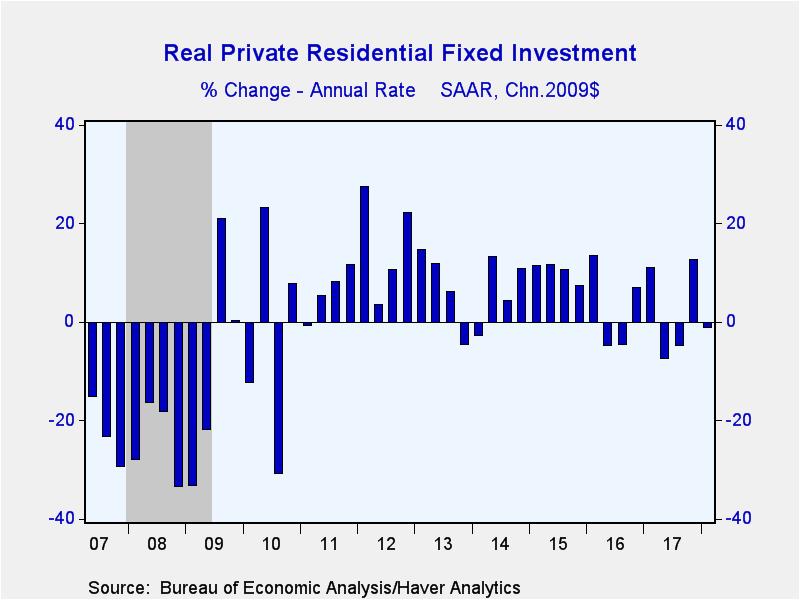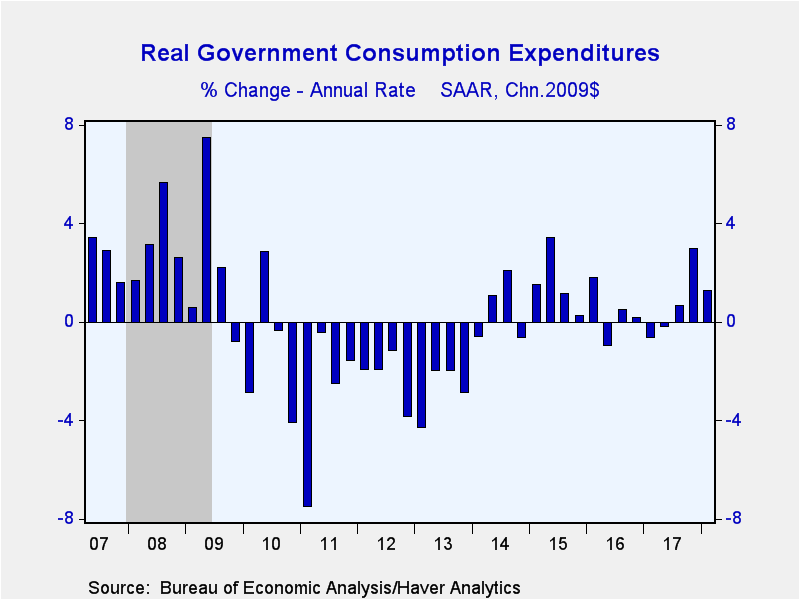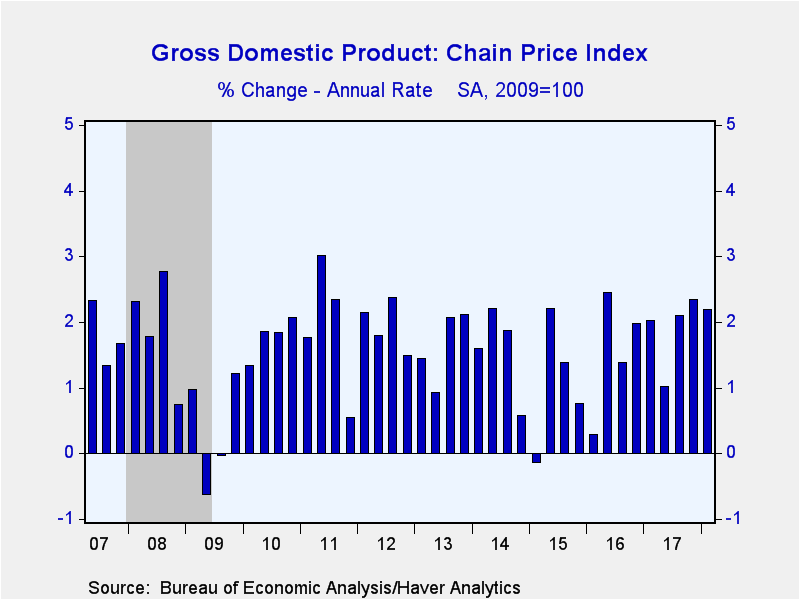 Global| Jun 28 2018
Global| Jun 28 2018U.S. GDP Growth Lowered; Corporate Profits Strengthened
by:Tom Moeller
|in:Economy in Brief
Summary
U.S. economic growth in Q1'18 moderated slightly more than earlier estimates. Real gross domestic product grew at a 2.0% annual rate, revised from 2.2% reported last month and 2.3% estimated initially. The rise followed 2.9% growth [...]
U.S. economic growth in Q1'18 moderated slightly more than earlier estimates. Real gross domestic product grew at a 2.0% annual rate, revised from 2.2% reported last month and 2.3% estimated initially. The rise followed 2.9% growth during Q4'17. A 2.2% increase had been expected in the Action Economics Forecast Survey. It remained the weakest rate of growth in four quarters. Growth in the GDP price index was revised to 2.2% (1.9% y/y) from 1.9%.
After-tax corporate profits without inventory valuation and capital consumption adjustments increased 10.6%, revised from 7.8%, following a 9.6% decline. Volatility may have been exaggerated by significant tax law changes. Pretax profits with IVA & CCA gained 1.8% (6.8% y/y), revised from -0.6%, after a 0.1% slip. Nonfinancial corporate earnings increased an upwardly revised 2.2% (9.7% y/y) after a 1.5% gain. Earnings in the financial sector improved a strengthened 1.5% after a 3.0% decline. Profits earned abroad rose a downwardly revised 0.8% following a 1.3% fall.
The contribution to overall economic growth from inventory investment was lessened slightly to zero from 0.1 percentage points. The contribution to growth from the foreign sector also was lessened to zero from 0.1 percentage points. Exports grew at a 3.6% rate (4.0% y/y) while imports rose 3.2% (4.4% y/y).
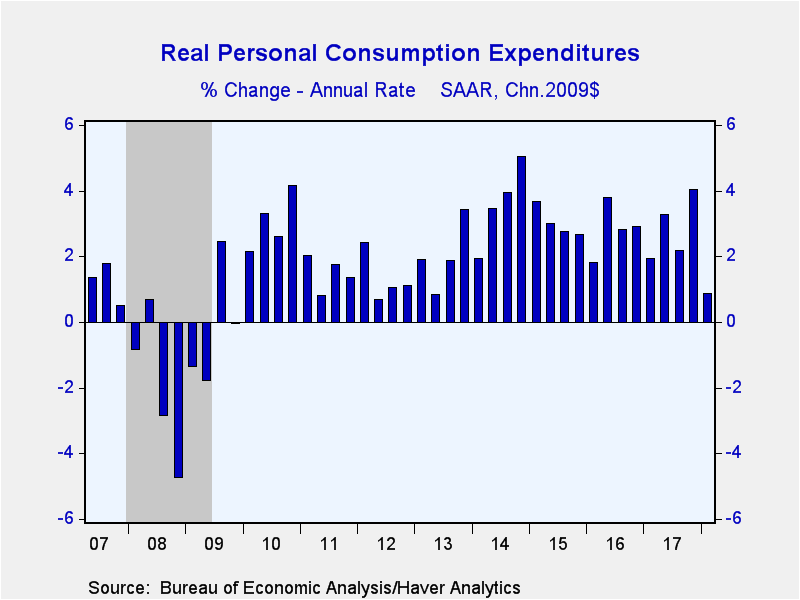 Growth in personal consumption expenditures was reduced to
0.9% (2.6% y/y) from 1.0%, following a 4.0% quarterly gain. It was the weakest
increase since Q2'13. Spending on durable goods fell 2.1% (+6.8% y/y), the first
decline since Q2'11. Spending was pulled down by a 12.4% drop (+4.2% y/y) in
motor vehicle & parts purchases that followed two double-digit quarterly
improvements. Spending on furniture & appliances rose 1.3% (8.0% y/y) after
a 13.1% rise. Recreational goods & vehicles buying rose 5.6% (8.0% y/y)
following a 12.8% jump. Purchases of nondurable products nudged 0.5% higher
(3.0% y/y) following a 4.8% gain. Clothing & shoe purchases fell 8.1% (+2.7%
y/y) and reversed a 10.6% jump. Spending on gasoline & oil fell 3.0% (+0.6%
y/y), the second decline in three quarters. Food & beverage buying rose 1.1%
(2.8% y/y) following a 6.8% strengthening. Spending growth on services of 1.5%
(1.8% y/y) followed 2.3% growth. The rise was weakened by a 0.3% gain (1.4% y/y)
in spending on housing utilities which came after a 2.1% increase. Health care
outlays grew 0.4% (2.2% y/y). It was the weakest increase since a Q1'14 decline
and followed two quarters of strong gain. Recreation outlays rose 1.1% (0.5%
y/y) after a 0.9% decline. Food services & hotel purchases jumped 3.3% (1.3%
y/y), the strongest increase in nearly two years.
Growth in personal consumption expenditures was reduced to
0.9% (2.6% y/y) from 1.0%, following a 4.0% quarterly gain. It was the weakest
increase since Q2'13. Spending on durable goods fell 2.1% (+6.8% y/y), the first
decline since Q2'11. Spending was pulled down by a 12.4% drop (+4.2% y/y) in
motor vehicle & parts purchases that followed two double-digit quarterly
improvements. Spending on furniture & appliances rose 1.3% (8.0% y/y) after
a 13.1% rise. Recreational goods & vehicles buying rose 5.6% (8.0% y/y)
following a 12.8% jump. Purchases of nondurable products nudged 0.5% higher
(3.0% y/y) following a 4.8% gain. Clothing & shoe purchases fell 8.1% (+2.7%
y/y) and reversed a 10.6% jump. Spending on gasoline & oil fell 3.0% (+0.6%
y/y), the second decline in three quarters. Food & beverage buying rose 1.1%
(2.8% y/y) following a 6.8% strengthening. Spending growth on services of 1.5%
(1.8% y/y) followed 2.3% growth. The rise was weakened by a 0.3% gain (1.4% y/y)
in spending on housing utilities which came after a 2.1% increase. Health care
outlays grew 0.4% (2.2% y/y). It was the weakest increase since a Q1'14 decline
and followed two quarters of strong gain. Recreation outlays rose 1.1% (0.5%
y/y) after a 0.9% decline. Food services & hotel purchases jumped 3.3% (1.3%
y/y), the strongest increase in nearly two years.
Growth in business fixed investment was strengthened to 10.4% (7.1% y/y) from 9.2%. It was the strongest rise since Q3'14 and led by a 16.2% jump (5.3% y/y) in structures investment. Equipment investment rose 5.8% (9.2% y/y) following two straight quarters of double-digit gain. Intellectual property products purchases surged 13.1% (5.6% y/y) and built on a 0.9% Q4'17 uptick. Information processing equipment investment strengthened 11.7% (10.4% y/y), the third double-digit rise in four quarters. Investment in computers & peripherals rebounded 37.2%, following a 27.6% decline. Investment in industrial equipment rose 6.2% (7.5% y/y) after a 4.6% rise.
The fall in residential investment was lessened to 1.1% (-0.4% y/y) from -2.0% reported last month. These declines followed a 12.8% recovery during Q4'17.
Growth in government spending was improved slightly to 1.3% (1.2% y/y) after a 3.0% Q4'17 rise. Federal government purchases increased 1.7% (2.0% y/y) as defense outlays rose 1.8% (3.6% y/y) after a 5.5% jump. State & local government purchases increased 1.0% (0.7% y/y) following a 2.9% gain.
Growth in the GDP price index was revised higher to 2.2% (1.9% y/y), above expectations for no change from the 1.9% gain estimated last month. The PCE price index increased 2.5% (1.8% y/y) following a 2.7% gain in Q4'17. These were the strongest price gains since early-2011. The PCE price index less food & energy rose 2.3% (1.6% y/y), up from little growth back in Q2'17. The PCE services price index strengthened 2.8% (2.5% y/y), after a 3.2% rise. The PCE nondurable goods price index rose 3.9% (1.6% y/y), about the same as in Q4'17. The PCE durable goods price index declined 1.5% (-2.4% y/y), following a 2.1% fall. The business fixed investment price index improved 1.3% (1.2% y/y), after a 0.6% rise. The residential price index strengthened 8.3% (5.0% y/y), following a 2.5% rise. It was the strongest increase in four years. The government sector price index increased 3.4% (2.6% y/y) after a 3.0% rise. These increases compare to virtually no growth in 2015 & 2016.
The GDP figures can be found in Haver's USECON and USNA database. USNA contains virtually all of the Bureau of Economic Analysis' detail in the national accounts, including the integrated economic accounts and the recently added GDP data for U.S. Territories. The Action Economics consensus estimates can be found in AS1REPNA.
Economic Growth to Accelerate in 2018 and Then Ease in 2019 as Auto Sales Downshift from the Federal Reserve Bank of Chicago is available here.
Less Food & Energy
Tom Moeller
AuthorMore in Author Profile »Prior to joining Haver Analytics in 2000, Mr. Moeller worked as the Economist at Chancellor Capital Management from 1985 to 1999. There, he developed comprehensive economic forecasts and interpreted economic data for equity and fixed income portfolio managers. Also at Chancellor, Mr. Moeller worked as an equity analyst and was responsible for researching and rating companies in the economically sensitive automobile and housing industries for investment in Chancellor’s equity portfolio. Prior to joining Chancellor, Mr. Moeller was an Economist at Citibank from 1979 to 1984. He also analyzed pricing behavior in the metals industry for the Council on Wage and Price Stability in Washington, D.C. In 1999, Mr. Moeller received the award for most accurate forecast from the Forecasters' Club of New York. From 1990 to 1992 he was President of the New York Association for Business Economists. Mr. Moeller earned an M.B.A. in Finance from Fordham University, where he graduated in 1987. He holds a Bachelor of Arts in Economics from George Washington University.


